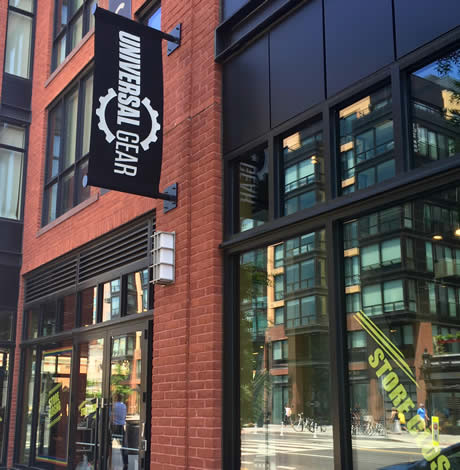Financial
A striking new ‘View’ on 14th Street

David Franco, a longtime local entrepreneur who co-owns Level 2 Development, opened View 14, a 185-unit apartment building in the bustling 14th and U corridor. (DC Agenda photo by Michael Key)
David Franco laughs as he recalls his foray into the entrepreneurial arena. It was 1989 and his good friend, John Guggenmos, was pulling together a group of investors to buy the nightclub Tracks. Franco, a fresh-faced 24-year-old, could not have known that Tracks would shortly experience its heyday and become the focal point of D.C.’s gay nightlife scene, making it a hugely profitable venture, but he smelled opportunity. Or at the very least a really good time. He was ready to jump at the chance.
There was just one snag: “I was not out at the time.”
Franco wasn’t among the legions of gay men and lesbians who came to D.C. to explore and embrace life outside the closet. The recent University of Maryland graduate was a native Washingtonian who had never lived anywhere else. He and his four brothers worked for the family business, a chain of discount department stores run by their father, and they all lived within a mile of each other in the Maryland suburbs. How would his family, especially his Orthodox Jewish father, react to having a family member who was not only gay but owned a gay nightclub?
“I went to my father and said, ‘Dad, I have this opportunity and the opportunity requires me to leave the family business.’” When his father asked what the opportunity was, Franco forced the words out. “I said, ‘I have the opportunity to go in with a group of guys to buy a [gay] nightclub.’ I thought my father was going to hit the roof. But instead he said, ‘If this is going to make you happy, you have my blessing.’”
The Tracks venture was the first step along a career path that would see Franco launch with his Tracks associates a new gay establishment in D.C., Trumpets restaurant, and with business partner Keith Clark start Universal Gear, a chain of clothing stores popular with gay men. Those accomplishments, however, were dwarfed with the opening last month of View 14, a $90 million 185-unit apartment building that he and business partner Jeff Blum developed and built through their real estate firm, Level 2 Development.
The building’s interior was designed in collaboration with local furniture store owners Jason Claire and Eric Kole of Vastu and has the feel of a boutique hotel: funky but modern, stylish with some flashes of whimsy. It boasts the usual upscale finishes like granite countertops and stainless steel appliances and an enviable array of amenities, some the kind you would expect in a new luxury building – roof decks with Weber grills, a party room, 24-hour concierge service, fitness center, underground parking – but some you might not have seen elsewhere, including a sculpture garden, yoga studio, fully loaded theater, and a screen in the cavernous lobby that tells you when the next green and yellow line trains will be arriving at the U Street Metro Station.
Franco likens View 14 itself to a “giant ship coming down 14th Street.” It’s a very fitting image, with the sleek and majestic glass, steel and stone structure seeming to glide down the hill from Columbia Heights to the U Street area. How View 14 came to be is a harrowing voyage in itself, fraught with the squalls and swells of a tanking real estate market and the ensuing lending crisis.
It was 2005, and Franco and Blum were finishing their first venture together, the development of a 12-unit apartment building on the 1400 block of Chapin Street, N.W., called the Mercury at Meridian Hill Park. The real estate market was moving from high gear into overdrive, Franco said, and the building sold out very quickly. Flush with excitement, the two decided that for their second project together they would go big in order to capitalize on the red hot market.
After losing a bid on a property in the NoMa neighborhood, they set their sights on the Petrovich Auto Repair garage at the corner of 14th Street and Florida Avenue, around the corner from the Mercury. The property was perfectly situated on a hill that would afford stunning views of the city, and was within a stone’s throw of the popular U Street corridor.
Unfortunately, owners Paolo and Pedro Petrovich weren’t exactly jumping at the opportunity.
“They weren’t prepared [to sell] at that time,” said Franco. “They wanted to reinvest [whatever profit they would make from the sale] but didn’t know what to do.”
Undeterred, Franco and Blum made themselves a fixture at the Petroviches’ garage. “One of us would be in there at least once a week, seeing how things were,” often over lunch. “We really cultivated a relationship.” Franco, meanwhile, diligently researched opportunities for the Petroviches to reinvest their money. When the brothers took him up on a suggestion to tour some CVS stores in the Baltimore area, Franco began to feel guardedly optimistic.
Several months later, after a delicate dance with the Petroviches that could only be described as a wooing, complete with the appearance of a rival suitor, Franco and Blum won the sale.
Once that first major hurdle was cleared other challenges followed – finding a suitable architect and investment partner, navigating city bureaucracy to get the requisite permits to build a large scale condo building where an auto repair shop used to be, making expensive arrangements for the grounds to be cleansed of several decades worth of oil and gasoline seepage – but those were overcome with hard work and perseverance.
Franco and Blum quickly found strong support for their project among D.C. politicians, with Mayor Adrian Fenty attending the groundbreaking and Ward 1 Council member Jim Graham stepping in to facilitate communication with Comcast, which had been unresponsive to Franco and Blum’s appeals to discuss with them the relocation of Comcast-owned satellite dish equipment and a signal receiver tower from the View 14 site. Graham would later champion legislation that gave the View 14 project $5.7 million in tax abatement.
The View 14 developers also won kudos from local community leaders and the city government by donating $1 million to the residents of Cresthill Apartments toward the purchase of their building and the formation of a cooperative. This was done as part of their deal with the city, which requires developers to provide affordable housing if they are building a high-density project. Rather than set aside units in the new building for that purpose, as is normally done, the View 14 developers, seeing need in their community, chose instead to donate needed funds to the Cresthill residents, whose building was less than a block away and was soon to be sold on the open market.
“I never will forget the first day I met David,” said Sankofa Cooperative president Sheila Royster, who has lived in the Cresthill Apartments building for 40 years. “He came to my unit and he brought me a plant. I thought that was wonderful. It was a genuine gesture and to me it just demonstrated his respect for us and what we were doing.”
Dark clouds began to loom though as speculation that the housing market was cresting gave way to fears of a housing bubble that could burst at any moment and send property values tumbling. Still, Franco and Blum were confident. More than 1,000 people attended the lavish launch party in September of 2006. Rival developers nervously dubbed View 14 “The Death Star” because it was expected to “suck up all the other condo purchasers in the market,” Franco said. “We were excited.”
Contracts trickled in, a dozen and a half in the first two months, and the cold reality set in: they weren’t selling enough units to finance the start of construction on time. It might be months, or even a year, before they reached that point. If they were able to reach that point.
The two men sat down with their project partners and made the difficult decision to re-engineer View 14 as a rental project. “It was literally the million dollar decision for us,” said Franco. “We had spent a million dollars in marketing and building a sales center.”
Franco said that he and Blum have accepted a letter of intent from a “well-known retail and services establishment in the area” that will use 8,000 square feet of space to expand their facilities.
“The neighborhood is going to be ecstatic when they learn who’s going to be there,” he promises. A signed lease and announcement is expected soon.
Franco is just as ebullient when he talks about the 14th and U Street neighborhood and its future. He points out that the Solea, a condo building directly across 14th Street from View 14, has nearly sold out. And there is just one unit left for sale at Union Row, the massive, 216-unit condo building that also houses Yes! Market, a CVS, and the restaurant Eatonville.
“That speaks volumes to the desirability of this neighborhood,” said Franco.
About 25 leases have been signed so far and the first View 14 residents moved in over Thanksgiving weekend, among them Galan Panger, a 24-year-old gay man who is leasing a studio. Panger, who works in Google’s downtown D.C. office, said he was impressed by the quality of the building’s construction and with the finishes. The amenities solidified the decision to trade in his digs at nearby Union Row for View 14.
“It was nice of them to create these community spaces,” Panger said. “My boyfriend and I have been grilling even though it’s been cold.” They have been sticking to the east roof deck after Franco joked during a tour of the building that it was the gayer of the two rooftop spaces since it has “the more fabulous view.”
Franco himself is one of View 14’s newest tenants, along with his dog; last week he sold his home near Meridian Hill Park and they moved into one of the penthouse units.
Franco sees a wide mix of people coming to View 14, from single young professionals to retired couples. There is also a fair bit of traffic from gay and lesbian renters like Panger, which Franco attributes to a variety of factors, including the fact that the building bears the strong imprint of two openly gay men, he and Blum, as well as the influence of other gay men they know like Claire and Kole of Vastu and Chris Cahill, a good friend of Franco’s who works for Botanical Decorators and came up with the idea for using the courtyard space as a sculpture garden and helped select the sculptures and interior plants.
People, gay and straight alike, Franco observed, appreciate quality and, “not to rely too heavily on stereotypes, but gay men have a natural attention to detail. We as gay men are [attuned] to high style, high design and convenience. This building delivers that.”
Real Estate
Boosting your rental property’s curb appeal
Affordable upgrades to attract and keep tenants happy

In the District of Columbia, the rental market tends to open up significantly during the springtime for several reasons. First, spring brings about a sense of renewal and change, prompting many individuals and families to seek new living arrangements or embark on relocations. Additionally, the warmer weather and longer daylight hours make it more conducive for people to explore housing options, attend viewings, and make decisions about moving. Furthermore, spring often coincides with the end of academic terms, leading to an influx of students and young professionals entering the rental market.
Landlords and property managers also tend to schedule lease renewals or list new vacancies during this time, capitalizing on the increased demand and ensuring a steady turnover of tenants. In the competitive world of rental properties, attracting and retaining quality tenants can be challenging. However, with some strategic upgrades, property owners can significantly enhance their units’ appeal without breaking the bank. From enhancing curb appeal to interior upgrades, here are some practical and cost-effective ideas to make your rental property stand out in the market.
Curb appeal
First impressions matter, and curb appeal plays a crucial role in attracting potential tenants. Simple enhancements like freshening up the exterior paint, adding potted plants or flowers, and ensuring a well-maintained lawn can instantly elevate the property’s appearance. Installing outdoor lighting not only adds charm but also enhances safety and security.
Interior upgrades
Upgrade the kitchen and bathroom fixtures to modern, energy-efficient options. Consider replacing outdated appliances with newer models, which not only appeal to tenants but also contribute to energy savings. Fresh paint and updated flooring can transform the look of a space without a hefty investment. Additionally, replacing worn-out carpets with hardwood or laminate flooring can make the unit more attractive and easier to maintain.
Enhance storage
Maximize storage options by installing built-in shelves, cabinets, or closet organizers. Tenants appreciate ample storage space to keep their belongings organized, contributing to a clutter-free living environment.
Improve lighting
Brighten up the interiors by adding more lighting fixtures or replacing old bulbs with energy-efficient LED lights. Well-lit spaces appear more inviting and spacious, enhancing the overall ambiance of the rental unit.
Upgrade window treatments
Replace outdated curtains or blinds with modern window treatments that allow natural light to filter in while offering privacy. Opt for neutral colors and versatile styles that appeal to a wide range of tastes.
Focus on security
Invest in security features such as deadbolts, window locks, and a reliable alarm system to ensure the safety of your tenants. Feeling secure in their home is a top priority for renters, and these upgrades can provide meaningful, genuine peace of mind.
Enhance outdoor spaces
If your rental property includes outdoor areas like a patio or balcony, consider sprucing them up with comfortable seating, outdoor rugs, and potted plants. Creating inviting outdoor spaces expands the living area and adds value to the rental property.
As landlords, investing in the enhancement of your rental properties is not merely about improving aesthetics; it’s about investing in the satisfaction and well-being of your tenants, and ultimately, in the success of your investment. By implementing these practical and affordable upgrades, you’re not only increasing the desirability of your units but also demonstrating your commitment to providing a high-quality living experience.
These efforts translate into higher tenant retention rates, reduced vacancy periods, and ultimately, a healthier bottom line. Moreover, by prioritizing the comfort, safety, and happiness of your tenants, you’re fostering a sense of community and trust that can lead to long-term relationships and positive referrals. So, let’s embark on this journey of transformation together, turning rental properties into cherished homes and landlords into valued partners in creating exceptional living spaces.
Scott Bloom is owner and Senior Property Manager of Columbia Property Management. For more information and resources, visit ColumbiaPM.com.
Real Estate
Real estate agents work hard for that commission
Despite recent headlines, buyers and sellers benefit from our expertise

With there being a lot of noise in the media lately as I am sure you have read and heard headlines like “Gone are the days of the 6% commission” and “End of the good days of Realtors,” etc., I wanted to re-run a very short article of the long laundry list of things that well versed real estate agents bring to the table to earn that seldom 6% commission. It’s typically split in half and it has always been negotiable).
As a real estate professional you will go on listing appointments and buyer meetings to not only attempt to gain business but in doing so you also educate the general public on what it is that we as real estate professionals do. I know what you’re thinking – and if you’ve seen my photo before you wouldn’t be wrong to assume that I am cast in “Selling DC” as the lead villain. I am just waiting for that phone call! But in all seriousness, when I sit down to come up with a list of things to prove to prospective clients the value in working with me as their real estate professional, I am pretty blown away at the items and qualities that a trusted professional representing you in a real estate transaction is responsible for managing a myriad of tasks, including but not limiting to the following:
• Have a pulse on the marketplace to truly understand exactly what is happening from a buying and selling standpoint while also understanding the economic side of things – not just looking at interest rates. Why are rates where they are? What employers are laying off and could cause an influx of inventory? What are the trends for individuals moving IN or OUT of an area looking like? Forecasting the marketplace of all things that truly affect real estate is vital.
• Soft Skills – these are the skills often considered as customer service skills. The ability to be approachable by all types of people and ensure that you are open to receive information. Also – when telling you bad news – it’s important to ensure that it is done in a manner in which you, the receiver, will be pleasantly receptive.
• Pre-market vendors – not only are real estate professionals expected to market your home for sale or locate a home for you to purchase, we are also expected to have a list of pre-market vendors to which you can use for your lending needs, home inspection, title work, any fluffing and buffing needed pre market for the sale of your home such as a contractor, painter, landscaper etc. We have a book of extremely well vetted vendors that either I personally have used or past clients have used that can assist with your needs. This beats Googling for hours and accidentally choosing the wrong contractor. Section A of the pre-market vendor list includes those in which we real estate professionals use for marketing materials for your property – we will use the best photographers, have floor plans drawn for your property, video, staging, catering for brokers opens and the list goes on. Again – this is a well vetted list that we have worked on for years and done all of the heavy lifting and had those uncomfortable conversations when things are not properly executed – so you don’t have to.
• On Market Tasks – these are the tasks that most clients are unaware that we do. Oftentimes when a listing is on market – folks think that I am just cruising around in my convertible buying nice things. However I am in fact going around checking each listing on market to ensure that they are clean, the booties are replaced, marketing materials are stocked, light bulbs are all working, staging looks crisp and the list truly goes on. That of course, doesn’t include the tasks we do to properly market the property such as weekly email blasts, reaching out several times to follow up with showing agents to get their feedback, check the market to see what our competition looks like, what’s under contract and why, and again…..I could go on. Needless to say the most important and time consuming tasks are those that are done when the property is on market.
• “Contract to close” management – the term contract to close is pretty much what it sounds like – it’s what happens from the time we go under contract until we reach the closing finish line and you have those keys. Once a trusted real estate professional has fiercely negotiated on your behalf as a buyer, the fun starts. Again pops up this vendor list – helping guide you though selection of a home inspector, termite inspector, etc. for the inspections. A title attorney is needed (depending on your jurisdiction) and any other vendors for quotes like renovations, etc., that you might want done to the property. Once the inspection is completed and we go through possible re-negotiations then we must ensure that the lender has the documents needed from you completed in order to have the appraisal done to prove the value of the home you are under contract for. Now we are getting into the weeds – but once we are on the other side of things and the appraisal comes back at value and the loan is clear to close then we are at the finish line to your new home.
A similar story can be told if you are selling your home. The appraisal is a very important part of the checklist as that is the value in which your home is worth. The appraiser is a third party that neither the buyer, seller, lender or myself have any allegiance to. I do, however, have the duty to educate said appraiser on why I chose the listing price and how I came up with that value.
• Post-market vendors. As mentioned before, a real estate professional should have a book of well vetted vendors from which to choose. Looking at the list of vendors now that we are on the other side of the table – I can provide a cleaning person, HVAC contractor, someone to repair the sprinkler system, a dog walker, the best caterers and bakery in town. Further down the road I am able to provide a wonderful wealth manager who can tell you what to do with that piece of real estate you purchased some time ago and we could go on for days.
While you are fully entitled to not use a real estate agent during your real estate transaction, I do believe that it is well within the realm of possibilities to say that without one there would be loose ends not completely tied up, things mismanaged and possible delays that could cost real cash. All of that aside, it is also such a truly wonderful experience to work alongside a trusted professional that at the end of the transaction becomes a new friend and family member. Real estate professionals love what they do, they love real estate and people and sheepherding you through the home buying or selling process is what it’s all about to us.
Justin Noble is a Realtor with Sotheby’s international Realty licensed in D.C., Maryland, and Delaware for your DMV and Delaware Beach needs. Specializing in first-time homebuyers, development and new construction as well as estate sales, Justin is a well-versed agent, highly regarded, and provides white glove service at every price point. Reach him at 202-503-4243, [email protected] or BurnsandNoble.com.
Real Estate
Do you need title insurance?
Facilitating smoother and more efficient real estate transactions

A title search is an examination of public records to determine the legal ownership of a property and identify any claims or liens against it. This comprehensive investigation delves into deeds, mortgages, court records, tax records, and other documents related to the property’s history. The objective is to verify that the seller has the legal right to transfer ownership of the property and that there are no undisclosed issues that could cloud the title.
I would surmise that most buyers have never read their title report or policy and I confess that I was one of them until 2005, when I bought a house in San Diego. While I was “in escrow,” my agent presented me with a title report. My first reaction was, “What do I do with this?” He replied, “review it and sign indicating that it is acceptable.” I had no idea what to look for, since I had always had title companies to rely on for interpreting the results. Thankfully, it was a clean report with no liens on it other than the mortgage the seller would be paying off at settlement.
Here, only if anything is amiss will the title attorney notify the agents and advise what the parties need to do to satisfy any conditions that could prevent them from closing. Otherwise, you won’t see the report up front.
Why are title searches important?
- They verify the seller’s legal right to transfer ownership of the property, providing assurance to the buyer that they are purchasing a legitimate asset.
- They identify any outstanding liens, mortgages, or other encumbrances that could affect the property’s value or the buyer’s ability to obtain financing.
- A title insurance policy provides coverage for losses arising from title defects such as disputes, undisclosed easements, forgery, or fraud, offering peace of mind to both buyers and lenders.
The process starts with the retrieval of documents from various sources, including county clerk offices, tax assessor’s offices, and court records.
The records are then inspected to trace the chain of ownership and identify any potential issues. The title examiner verifies the accuracy of legal descriptions, checks for inconsistencies or errors, and identifies any red flags that may indicate title defects.
If found, resolution of issues or discrepancies, such as unpaid taxes, outstanding liens, or boundary disputes must be addressed before the transaction can proceed. This may involve negotiating with creditors to satisfy outstanding debts, requesting more information from sellers, and resolving legal disputes.
Once complete, the firm will issue a title report on which to base a title policy. The buyers will receive a copy at settlement. The report provides a detailed summary of the property’s ownership history, any encumbrances or defects found during the search, and recommendations for mitigating risks.
Title insurance for the lender is required, but buyers often ask whether they need owner’s title insurance coverage too. I always recommend buying an owner’s policy. If a buyer chooses not to, then only the lender is protected from any claims revealed after the issuance of the title report. For a one-time fee, an owner’s policy protects your interest in the property and that of any heirs from future claims until the house is ultimately sold.
For example, I attended a settlement with a buyer who was purchasing a rowhouse. A woman who had power of attorney to sign for the seller was also there and, because he was overseas, the actual seller was on speaker phone to address his concerns or ask any questions.
The closing agent began reading the settlement statement aloud to indicate what was being deducted from the seller’s proceeds. The seller was fine with the amount shown for the remainder of his first mortgage, but when she read out the amount of the second mortgage, the seller, now agitated, asked, “What second mortgage?”
It then became clear that the woman, the owner’s former fiancée, had used her power of attorney to obtain a second mortgage after the title search had been done. Thanks to the title companies’ involvement, the seller was able to post a bond for the missing funds to allow settlement to proceed while he took on a legal battle with his former fiancée. Don’t try this at home, kids.
By uncovering potential issues early in the process, title searches help facilitate smoother and more efficient real estate transactions by resolving issues upfront, ensuring a seamless transfer of property ownership. But nobody knows when great Uncle Bob or your former tenant may show up with a claim to the house. You’ll need your owner’s title policy to have someone on your side.
Valerie M. Blake is a licensed Associate Broker in D.C., Maryland, and Virginia with RLAH Real Estate / @properties. Call or text her at 202-246-8602, email her via DCHomeQuest.com, or follow her on Facebook at TheRealst8ofAffairs.

















